We love Japanese food, which is a big reason why Japan is one of our favorite countries in the world to visit. It’s an endlessly fascinating country with delicious food on every corner. To be honest, I can’t recall a single time when I didn’t enjoy a meal in Japan!
We can’t get enough of savory Japanese dishes like sushi, ramen, and tempura, but traditional Japanese sweets are something you need to try as well. Be sure to look for these 20 popular Japanese desserts on your next trip to Japan.
JAPANESE DESSERT QUICK LINKS
If you’re traveling to Japan and want to really dive into Japanese cuisine, then you may be interested in joining a food tour or taking a cooking class.
TOURS & OTHER SERVICES
- Food Tours: Food Tours in Japan
- Cooking Classes: Cooking Classes in Japan
- eSIM: Japan eSIM
Save This on Pinterest!
No time to read this article on the most popular Japanese desserts? Click on the save button and pin it for later!
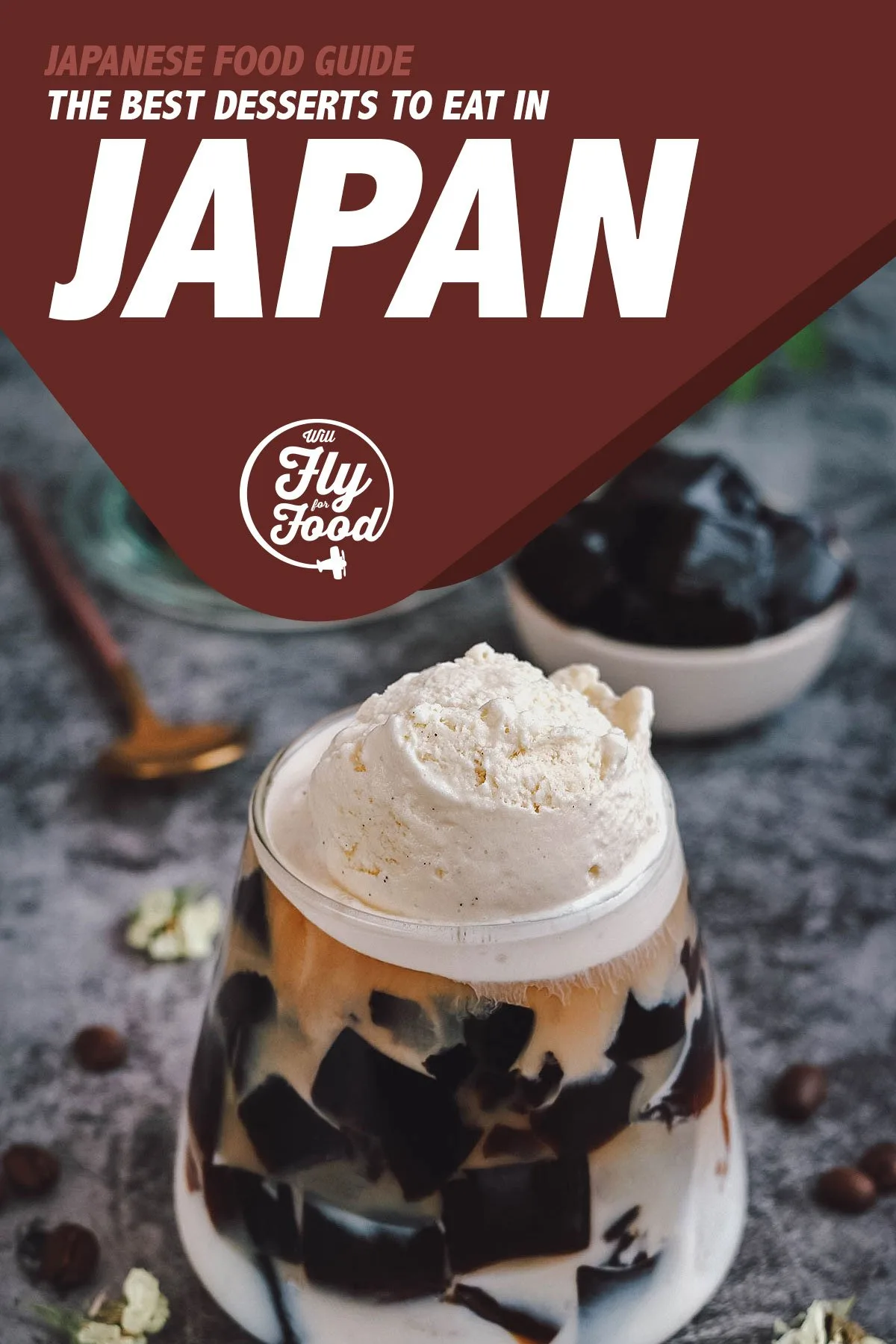
Photo by P-Kheawtasang
WHAT IS WAGASHI?
Before we get into the list of the most popular Japanese desserts, I just wanted to talk briefly about wagashi. It’s a term you’ll see often when reading about Japanese desserts and confections.
Wagashi refers to traditional Japanese confectionery often served with green tea. They’re artfully crafted tea-time desserts made with different ingredients and fillings like mochi, sweet red bean paste, fruits, nuts, and agar jelly.
Depending on how and where they’re made, you’ll find a wide variety of wagashi in Japan, some of which will be covered in this Japanese dessert guide.
MUST-TRY TRADITIONAL JAPANESE DESSERTS
1. Mochi
There’s no better way to start a list of traditional Japanese desserts than with mochi. This Japanese rice cake made from mochigome (Japanese glutinous rice) is an important festival food that’s been prepared in Japan for hundreds of years.
Mochi is a key component in seasonal festivals like the Japanese New Year but it’s commonly enjoyed throughout the year as well. Known for its wonderful sticky consistency, it’s made by pounding glutinous rice into a paste and then molding it into the desired shape. Mochi can be eaten on its own though it’s often made into other confections as well like wagashi and mochi ice cream.
Traditionally, mochi is made by two people that work in tandem to pound and wet the sticky sweet rice flour paste using a kine (wooden mallet) and usu (mortar). It’s a laborious but fascinating process to watch that you can still observe in some parts of Japan.
If you visit Nara, then I highly recommend looking for the Nakatanidou stall. Its owner – Mitsuo Nakatani – has a reputation for being the fastest mochi maker in Japan.
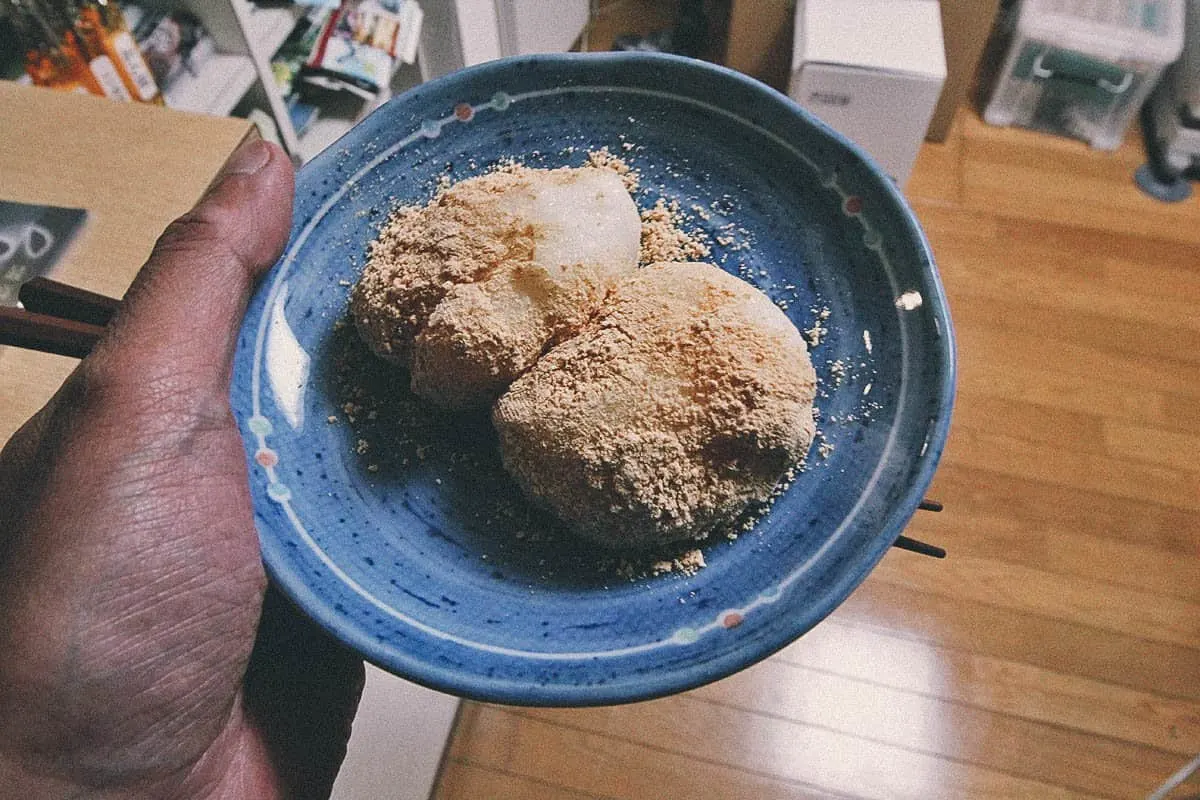
2. Sakuramochi
Sakuramochi refers to a type of wagashi made with pink-colored mochi filled with anko or sweet red bean paste. Wrapped in a pickled sakura (cherry blossom) leaf, this eye-catching confection is traditionally enjoyed in spring, particularly during hinamatsuri (Girls’ Day) and cherry blossom viewing events called hanami.
If you visit Japan in late March or early April – when the cherry trees are expected to bloom – then sakuramochi is one Japanese dessert that you should definitely look for.
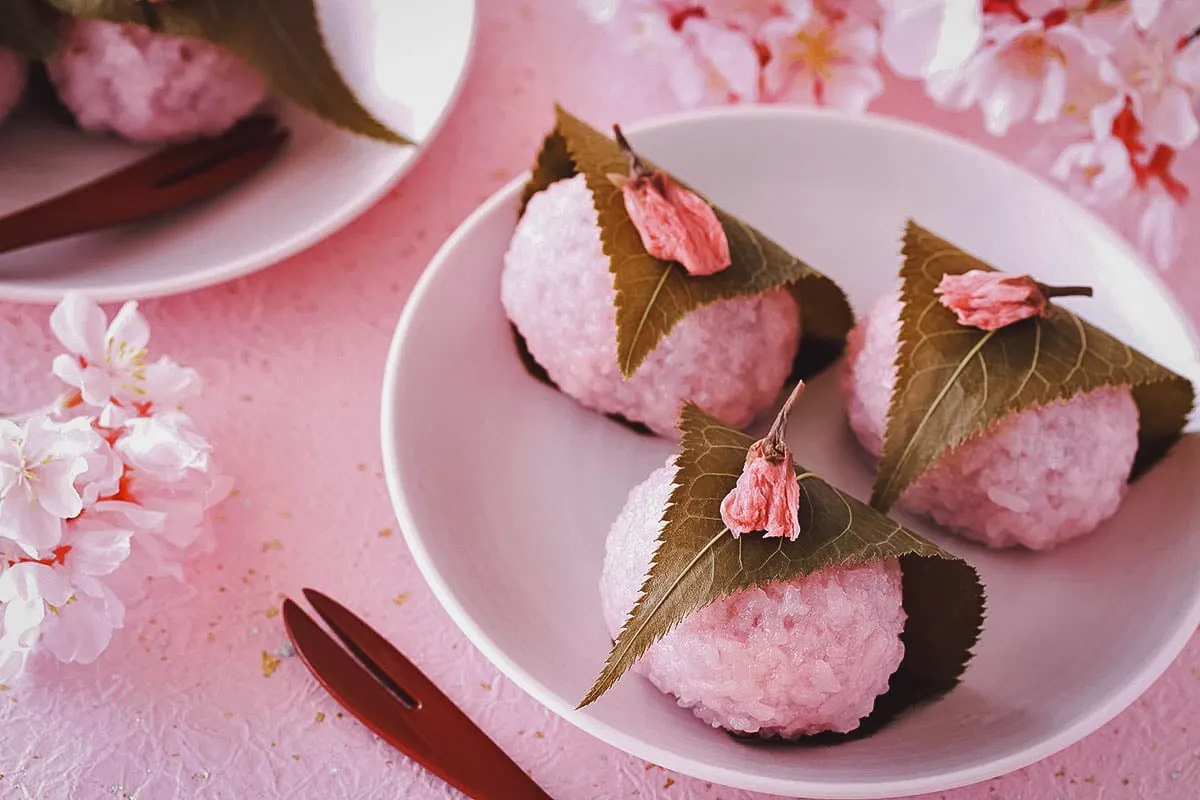
Photo by nana77777
3. Daifuku
Daifukumochi (or simply daifuku) is another popular type of wagashi made with mochi. It consists of a ball or sphere of mochi stuffed with a sweet filling, most commonly red bean paste.
Aside from sweet bean paste, daifuku can be made with different fillings and ingredients like apricot, chestnut, mugwort, and ice cream. The irresistible version stuffed with a whole strawberry below is called ichigo daifuku.
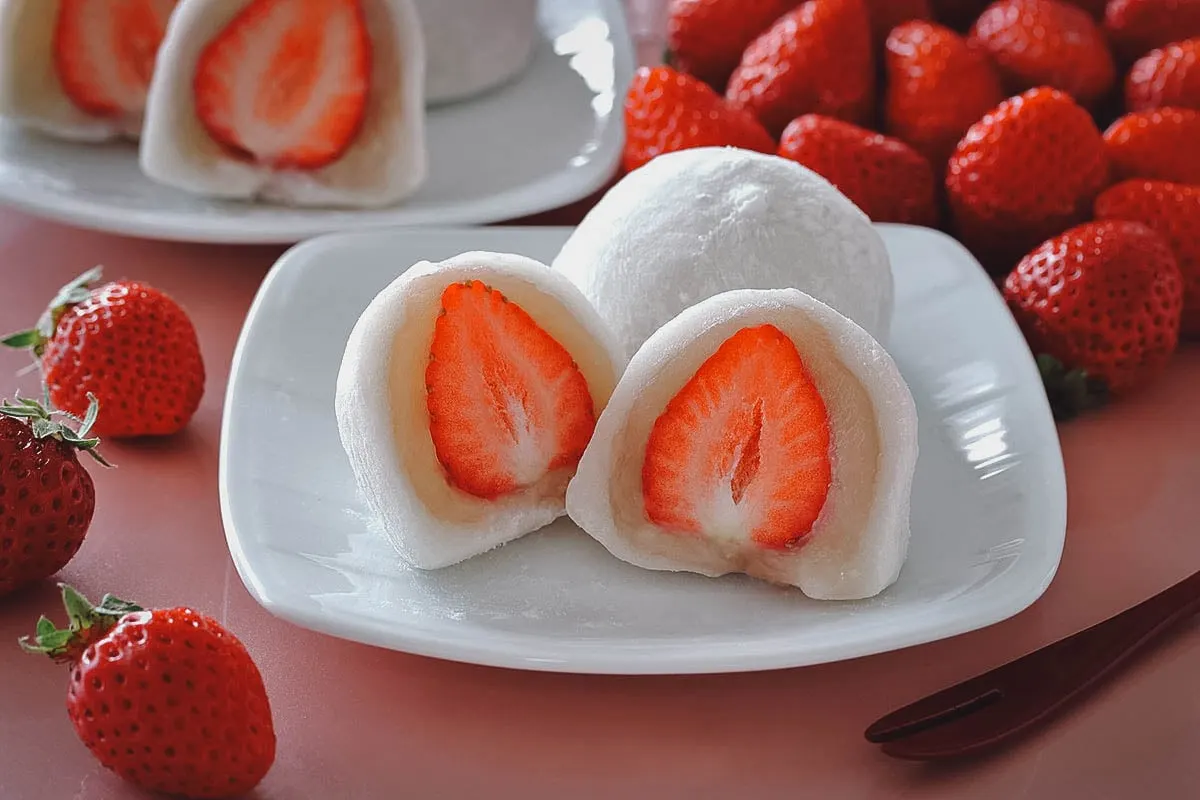
Photo by nana77777
4. Rakugan
The Japanese are masters at turning food into art and rakugan is a perfect example of that. A type of wagashi, it’s made with soybean flour, sugar, and different powders pressed into traditional wooden molds called kashigata.
Rakugan can be made into different shapes, colors, and sizes to reflect seasonal or regional themes. They’re traditionally consumed with tea and are especially popular in parts of Japan with a strong tea ceremony tradition, like Kanazawa.
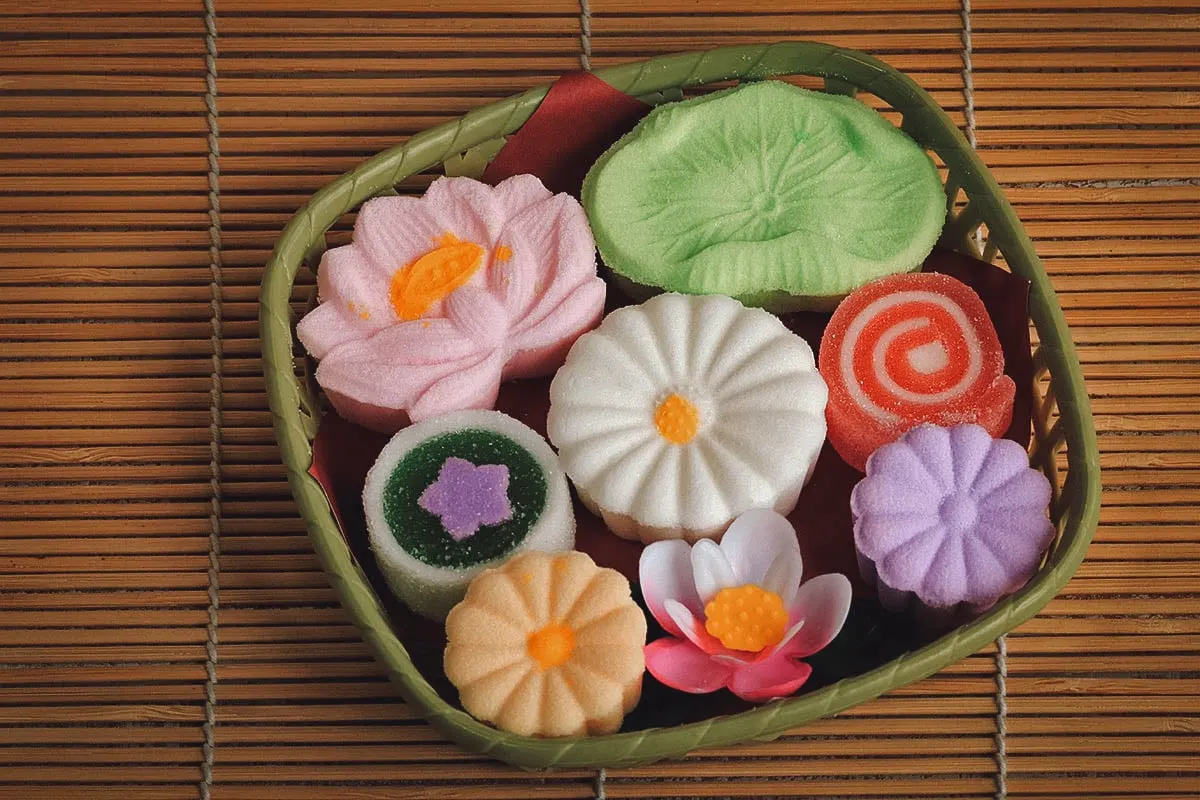
Photo by homi
5. Yokan
Yokan refers to a popular type of wagashi made with agar. Typically sold and eaten in block form, this traditional Japanese dessert is commonly made with sweet red bean paste but it can also be flavored with white kidney bean paste and other ingredients like chestnuts, figs, and Japanese sweet potatoes.
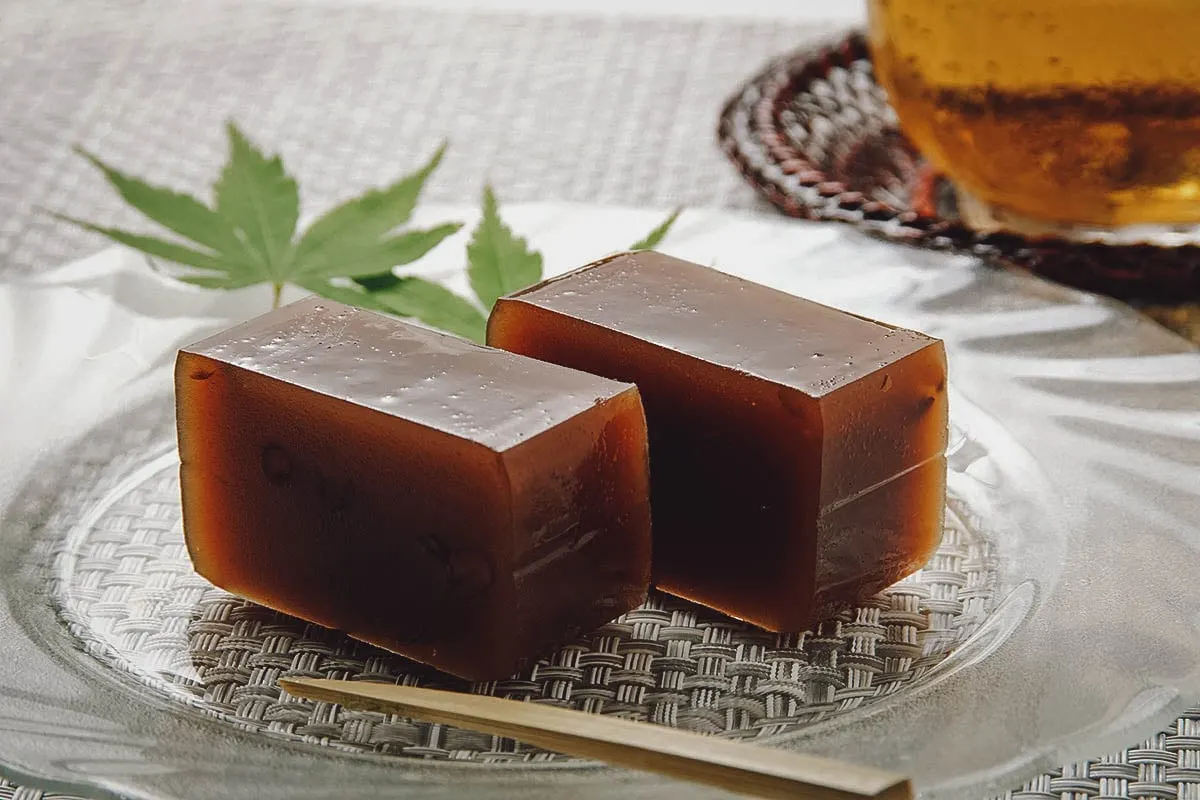
Photo by fumi901
6. Dango
Dango refers to a type of wagashi made from uruchi and glutinous rice flour. A popular street food in Japan, it has a mochi-like consistency and is typically sold on skewers with different glazes and coatings.
Depending on how and what it’s made with, there are many types of dango in Japan like mitarashi dango (glazed with soy sauce), anko dango (coated in sweet red bean paste), and hanami dango (three-colored dango).
Pictured below is a skewer of miso dango from a popular stall in Osaka. As its name suggests, it’s coated in a tasty miso glaze.
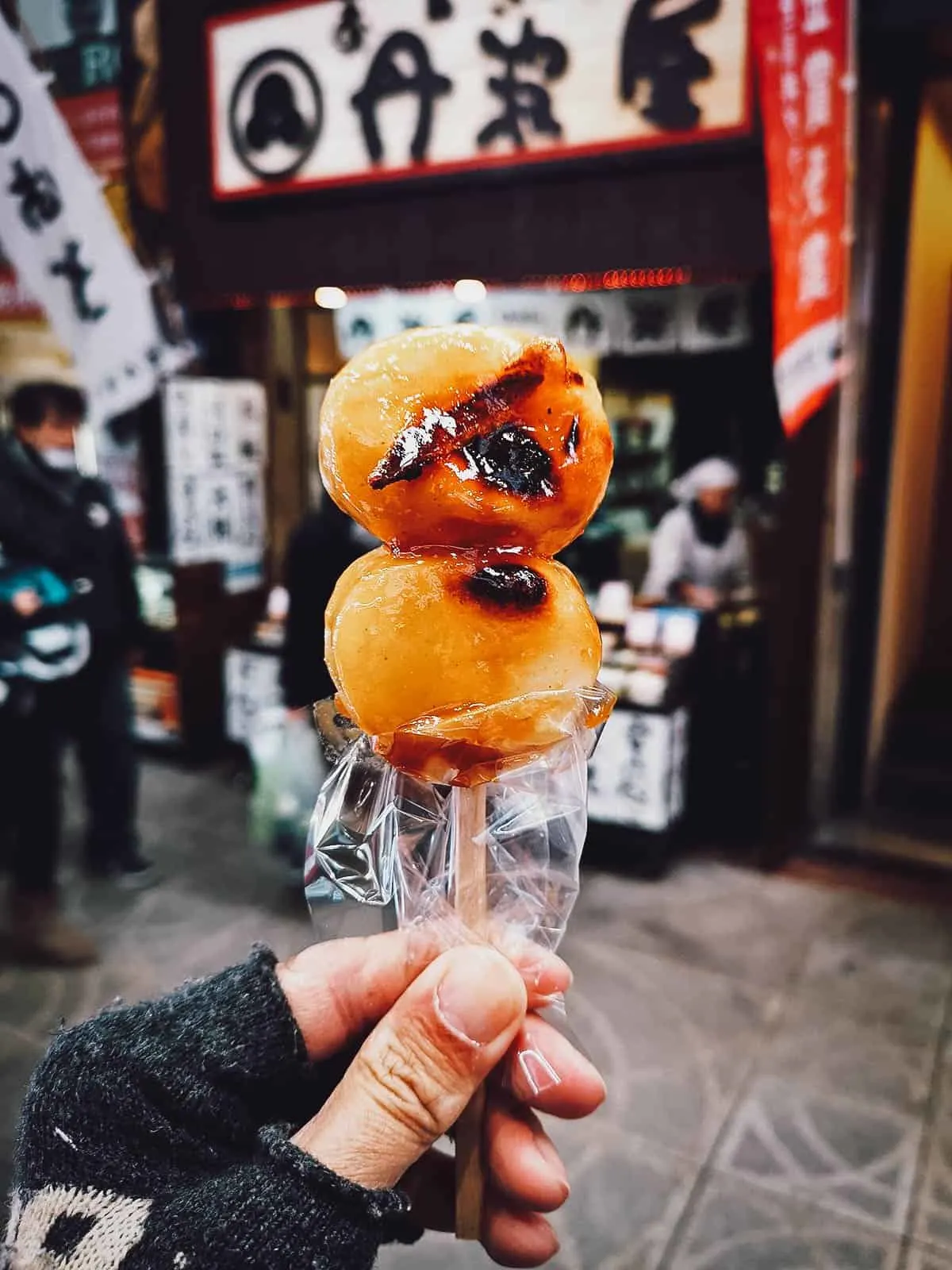
7. Daigaku Imo
Daigaku imo refers to a simple Japanese dessert made with candied sweet potatoes. A popular snack since the early 1900s, they consist of Japanese sweet potatoes covered in a hard sugar candy coating.
Food trivia buffs may be interested to learn that the name daigaku imo translates to “university potatoes”. Daigaku imo became a popular snack at universities in Tokyo in the early 1900s, hence the name.
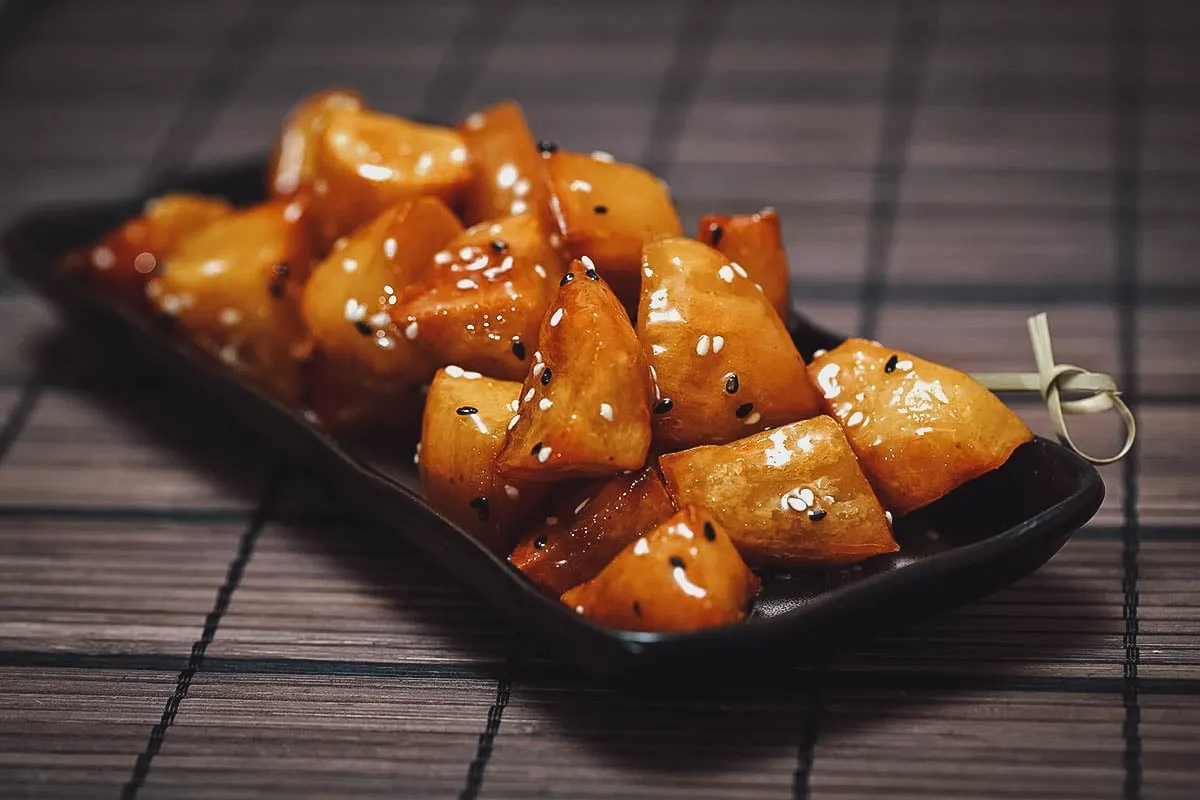
Photo by Chagiya_1.8.18
8. Imagawayaki
One of my closest friends is Japanese and he can’t get enough of these anko-filled Japanese sweets called imagawayaki. A popular street food in Japan, these pancake-like desserts are stuffed with a sweet red bean filling and cooked till crispy in disk-shaped cast iron molds.
Also known as kaitenyaki or obanyaki, imagawayaki are traditionally stuffed with red bean paste but they can be made with other fillings as well like vanilla custard, chocolate, and green tea. They can even be made with savory fillings like curry and cheese.
If you’ve been to Taiwan, then imagawayaki should be familiar to you. They’re known as wheel cakes in Taiwan and are a common sight at Taiwanese night markets.
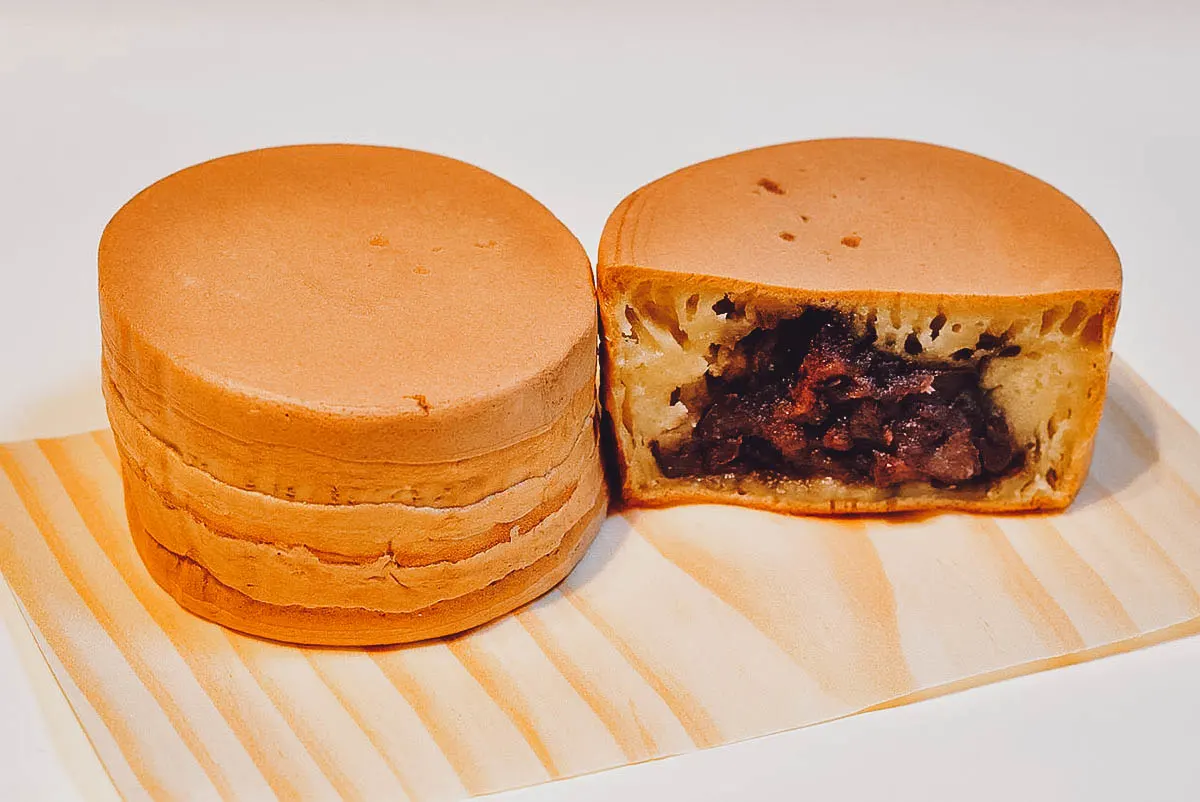
Ocdp, CC0, via Wikimedia Commons
9. Monaka
If you like the crisp airy texture of wafers, then you’re probably going to enjoy monaka. It’s a traditional Japanese dessert made with sweet red bean paste sandwiched between two mochi wafers.
Made in different shapes and designs, monaka is traditionally filled with red bean paste but it can be stuffed with ice cream as well.
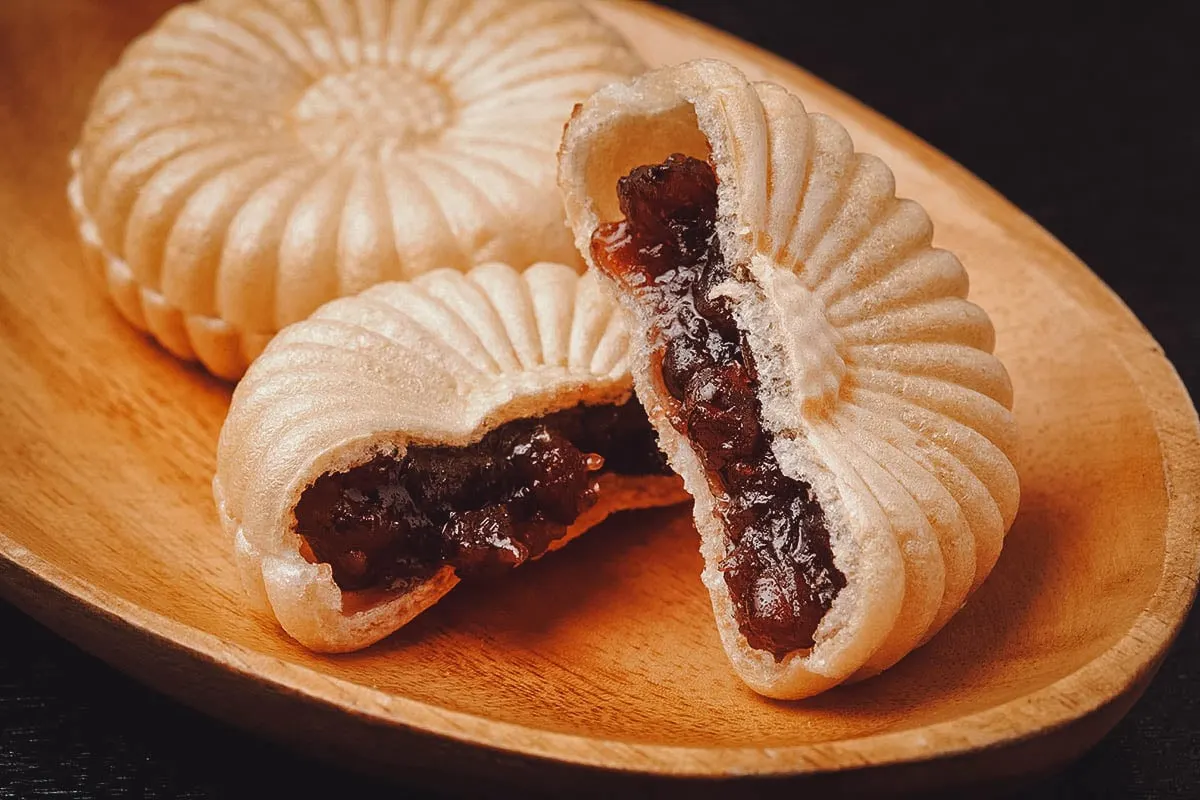
Photo by sasazawa
10. Taiyaki
Walk around the busiest parts of Dotonbori and it won’t be long before you find stalls selling taiyaki. It refers to this familiar-looking fish-shaped pastry filled with (you guessed it) sweet red bean paste.
Like imagawayaki, taiyaki is traditionally filled with sweet bean paste but it can be stuffed with other ingredients as well like custard, chocolate, and cheese. In fact, you can think of taiyaki as a fish-shaped version of imagawayaki.
Taiyaki is shaped like red seabreem – tai in Japanese – hence the name. Tai is considered a symbol of good luck in Japan.
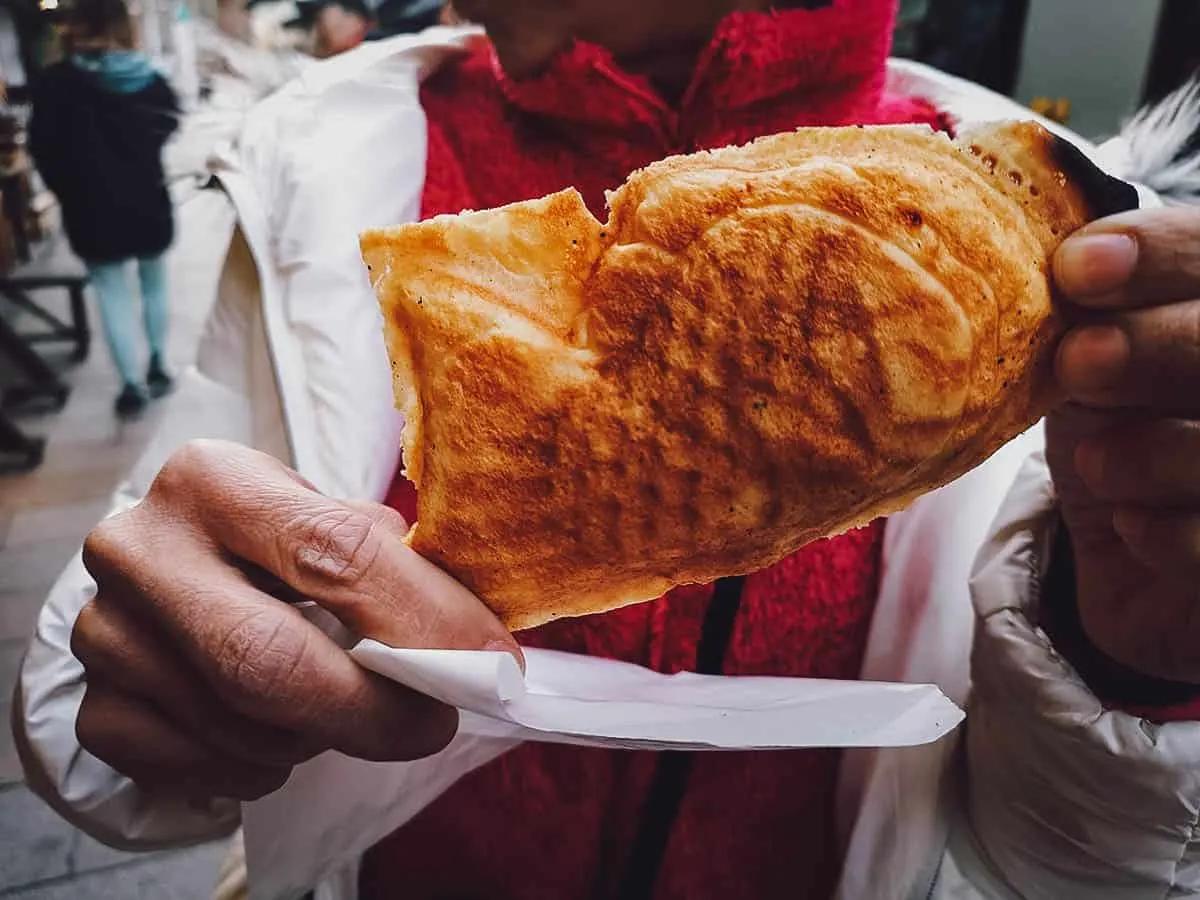
11. Dorayaki
Every night before retiring to our hotel, we’d make it a point to stop at a konbini (Japanese convenience store) and pick up a few snacks to eat for breakfast the next day. This pancake-like Japanese dessert called dorayaki often made it into our shopping basket.
Dorayaki is a type of Japanese dessert or snack made with sweet red bean paste sandwiched between two small castella pancakes. I’ll talk about it more later in this guide but castella refers to a type of Japanese-Portuguese sponge cake that’s considered a specialty of Nagasaki.
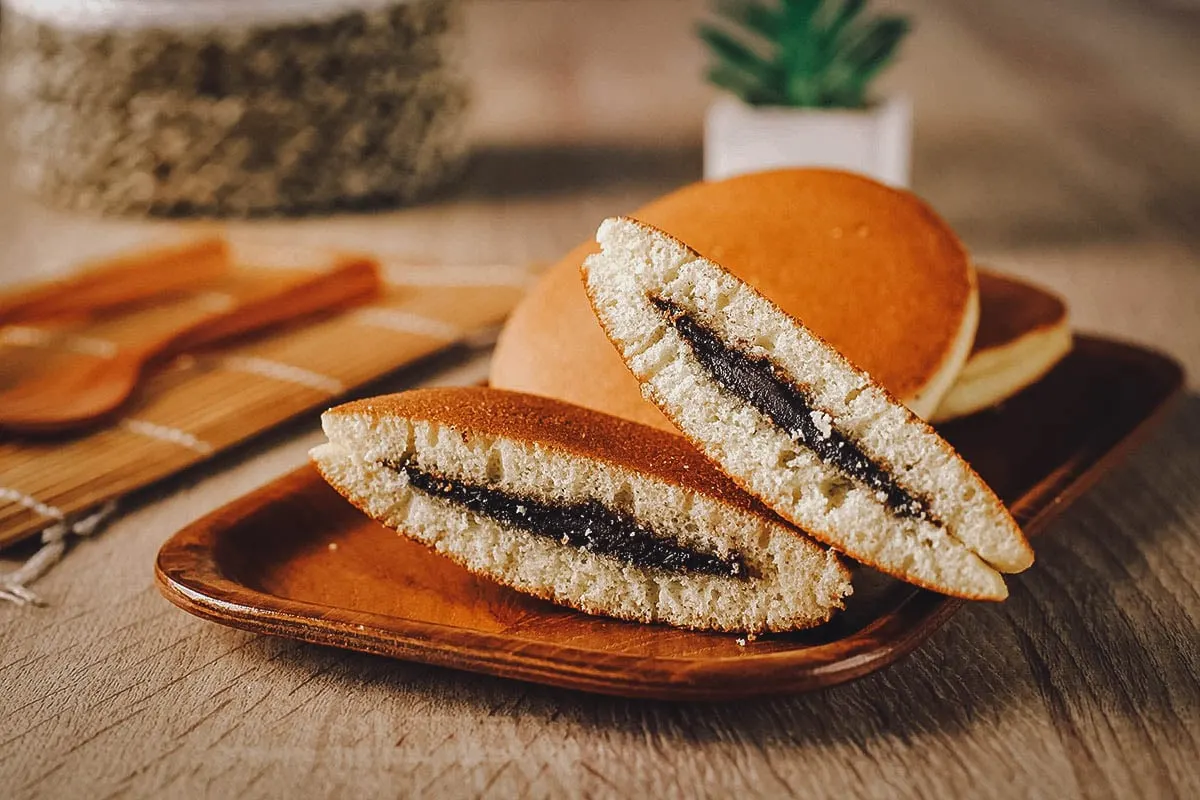
Photo by Gatot Adri
12. Souffle Pancakes
If you like thick fluffy pancakes, then you’re going to love soufflé pancakes. They’re Japanese pancakes made with the addition of extra egg whites, hence the extra height and fluffiness.
Japanese pancakes are made by beating a meringue mixture into the pancake batter and then cooking it in metal rings at low temperatures. This is what gives the pancakes their characteristic height.
The Japanese pancakes pictured below are drenched in a milky cream sauce but they can be served with different toppings and ingredients like powdered sugar, sweet syrup, fresh fruits, whipped cream, and ice cream.
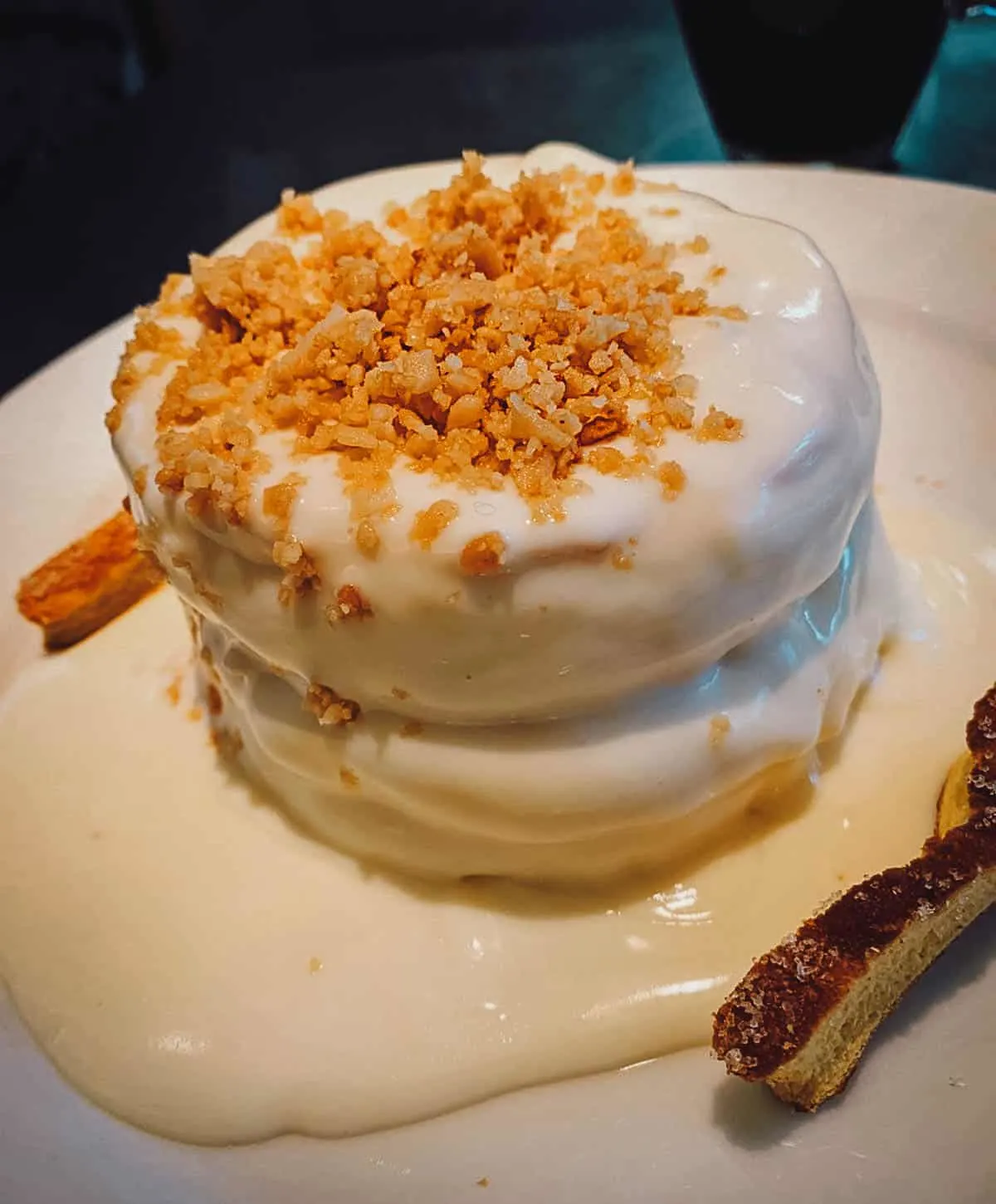
13. Japanese Cheesecake
Some people may not agree with this, but in my opinion, the Japanese make many dishes better. A case can be made for pizzas, burgers, and steaks and an argument can definitely be made for cheesecake. And a lot of that has to do with the quality of their dairy.
Hokkaido dairy is amazing. It’s known for its freshness and quality which is why dessert shops that use it let their customers know that their cakes and pastries are made with milk from Hokkaido. You can find many delicious Japanese desserts made with Hokkaido dairy like soft cream, custard, and cookies, but one of my favorites is Japanese cheesecake.
If you like cheesecake and are visiting Sapporo, then you absolutely need to try the double fromage cheesecake from LeTao. It could very well change your life.
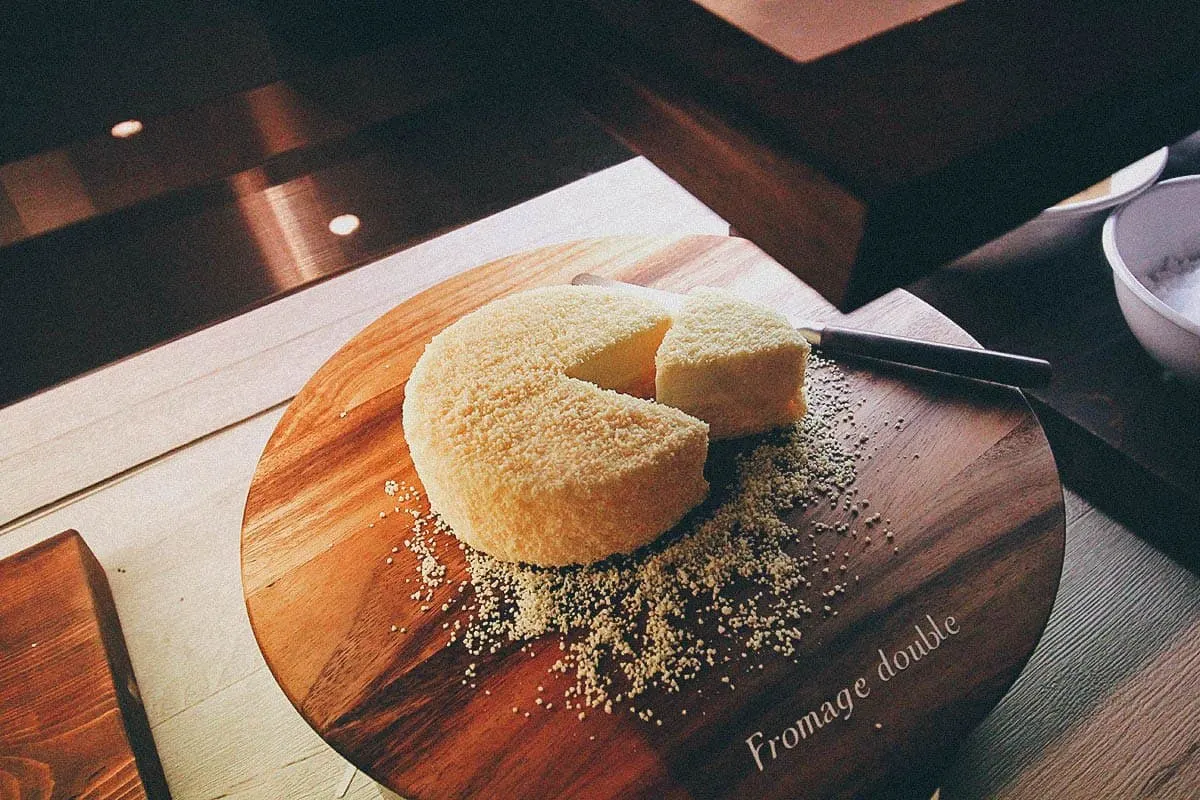
14. Matcha Basque Cheesecake
The Japanese version of this famous Spanish dessert is another sweet treat that cheesecake lovers need to try. Originally from San Sebastian, Basque burnt cheesecake is a version of cheesecake that’s recently taken the world by storm. Unlike New York cheesecake that’s evenly firm throughout, the Spanish version is soft and fluffy around the edges and gooier towards the center.
In Japan, you’ll find a variety of desserts made with matcha powder like green tea mochi, green tea ice cream, and green tea cookies. One of my favorites is green tea Basque cheesecake. Gooey Basque cheesecake with that irresistible matcha flavor. Need I say more?
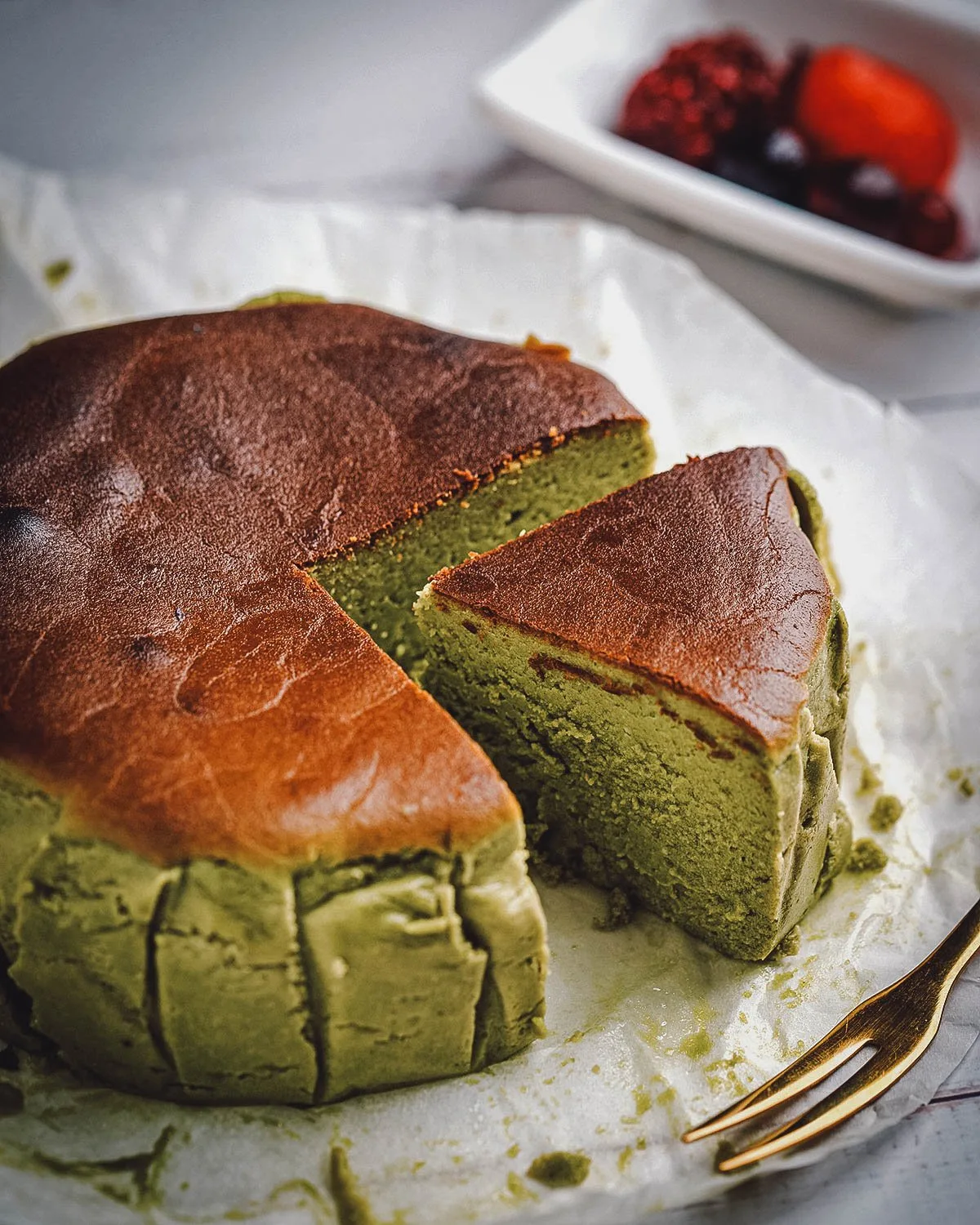
Photo by Papzi555
15. Mille Crepe Cake
It’s hard not to notice the many delicious Japanese pastries on display at dessert shops in Japan. Among the most eye-catching are these mille crepe cakes which are a common sight in big cities like Tokyo and Osaka.
I found it odd to see so many mille crepe cakes in Japan. I just assumed the locals were really into them but as it turns out, they were made famous by a Japanese woman named Emy Wada. She’s a pâtissier who studied in France and popularized mille crepe cakes at her Paper Moon Cake Boutiques in 1980s Japan. How cool!
Mille crepe cake literally means “thousand crepe cake”. Though it isn’t actually made with a thousand crepes, it refers to a Japanese cake made with a stack of crepes layered with different fillings.
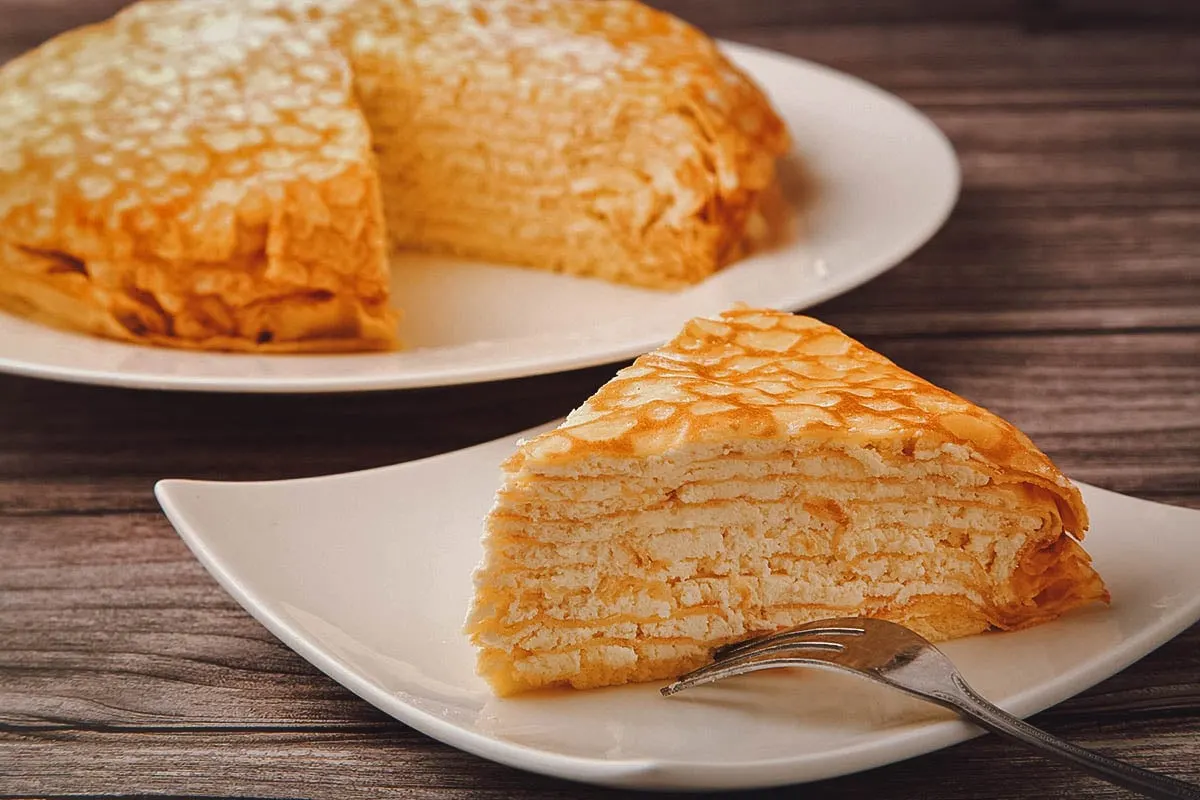
Photo by sasazawa
16. Castella Cake
As briefly touched upon in the dorayaki section of this guide, castella cake refers to a type of sponge cake that was brought to Japan by Portuguese merchants in the 16th century. At the time, Nagasaki was the only Japanese port open to foreign commerce, which is how castella cake came to be known as a specialty of Nagasaki.
Castella cake is believed to be derived from the Portuguese dessert pão de castela. Meaning “bread from Castille”, the Japanese adopted the recipe and called it kasutera (castella).
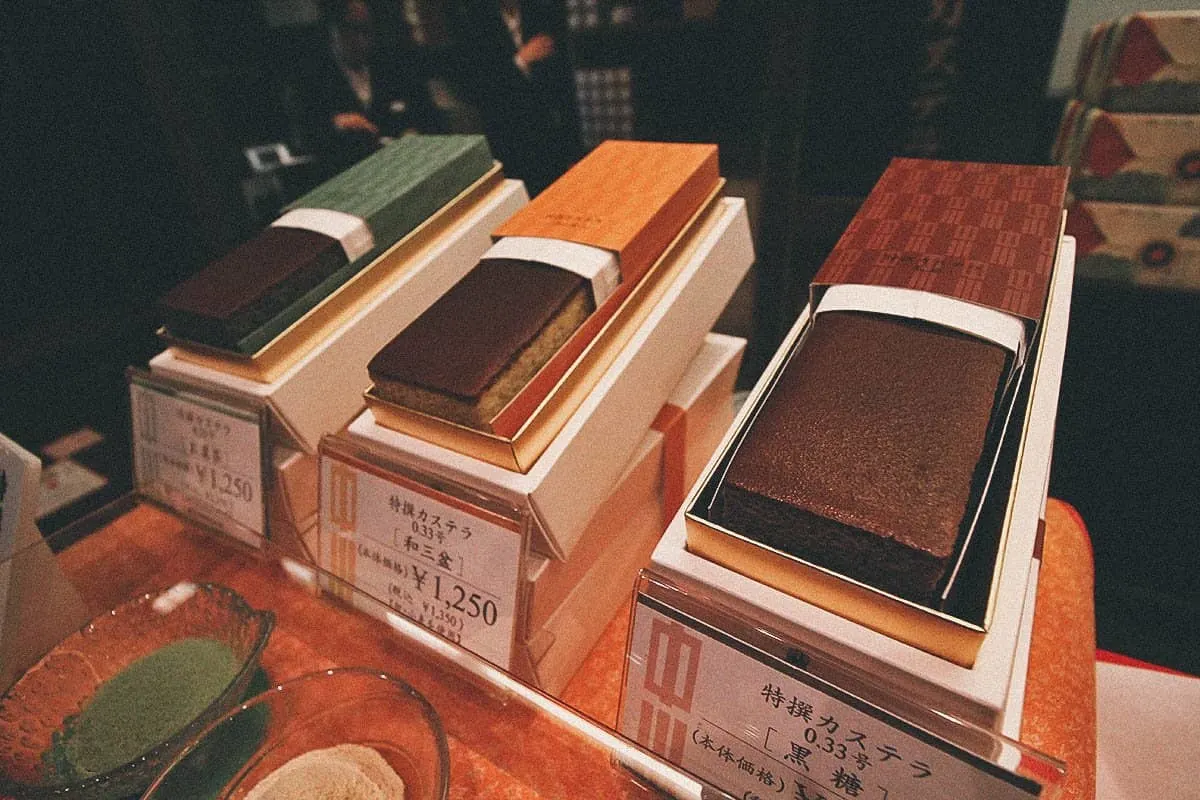
17. Melon Pan
We can’t get enough of Japanese konbini pastries and melon pan (melon bread) is another of our favorites. Similar in appearance to Hong Kong pineapple buns, they get their name from their passing resemblance to cantaloupes.
Melon pan is made from enriched dough topped with a thin layer of crisp cookie dough. Traditionally, they aren’t flavored with melon, though it’s become fashionable for some manufacturers to add melon flavoring to the bread.
Other flavors and ingredients used to make melon pan include maple syrup, whipped cream, custard, and chocolate chips.
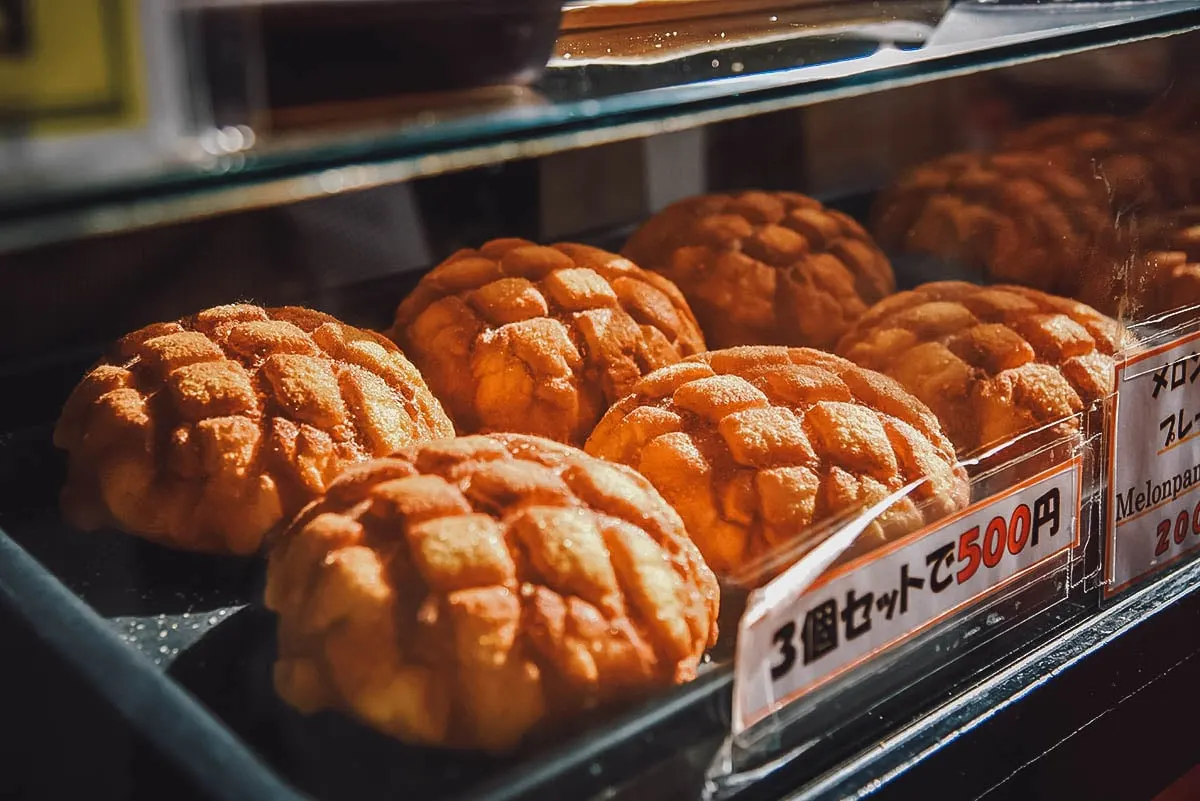
Photo by Cheezie Chicky Chick
18. Coffee Jelly
I’m a big coffee drinker so naturally, I’m drawn to anything made with coffee as well. Desserts like tiramisu and coffee ice cream get me weak in the knees but so does this refreshing treat called coffee jelly.
An old-school dessert, coffee jelly is made from coffee-flavored agar shaped into cubes. It can be enjoyed on its own, topped with fluffy whipped cream, or added to other drinks and desserts like ice cream floats, bubble tea, and iced coffee.
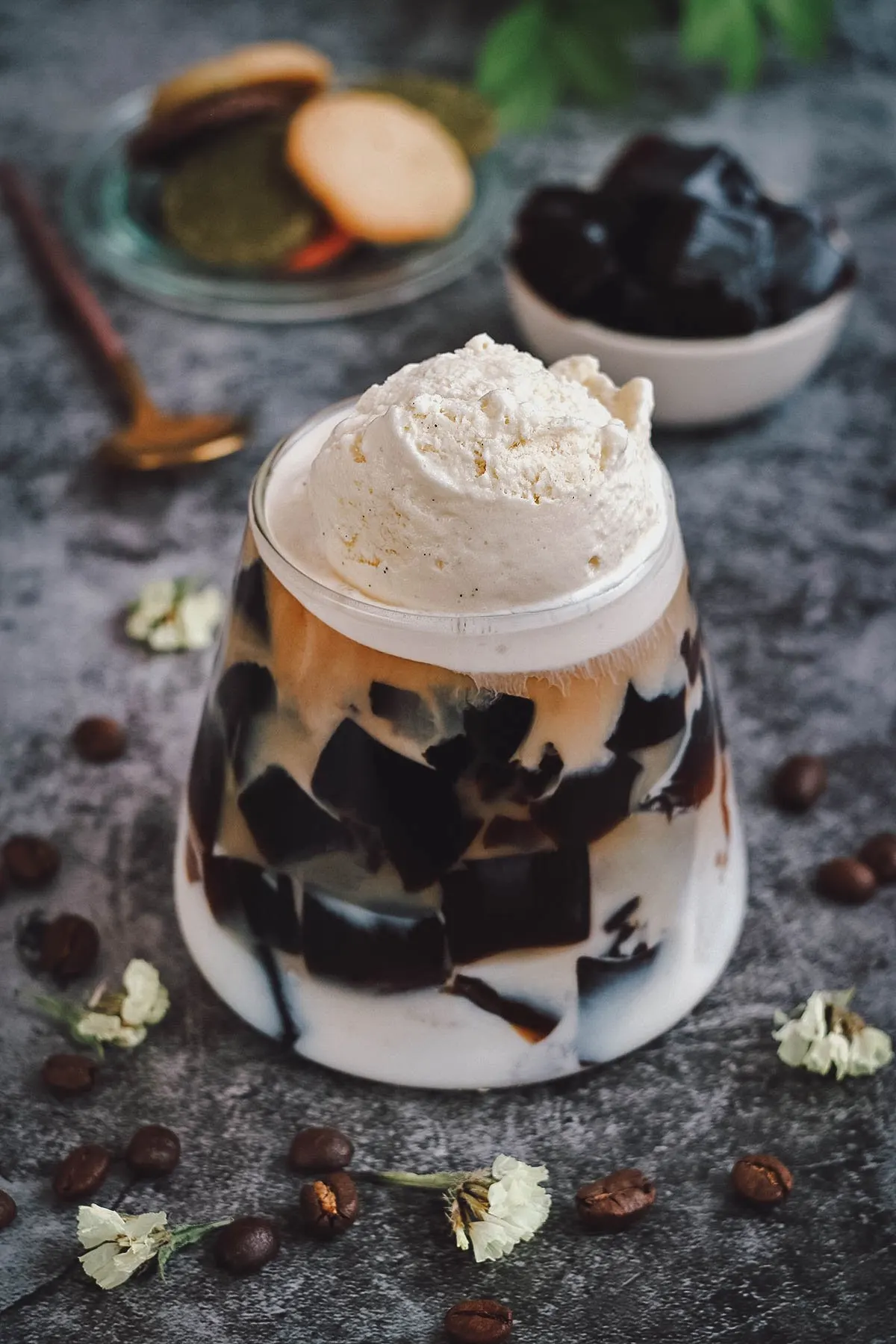
Photo by P-Kheawtasang
19. Kakigori
If you’re a fan of Korean bingsu, Filipino halo-halo, or Malaysian ais kacang, then you’ll probably enjoy kakigori as well. It’s a Japanese shaved ice dessert flavored with condensed milk and a variety of different syrups.
Similar to a snow cone but fluffier, popular kakigori flavors include cherry, strawberry, melon, green tea, and lemon.
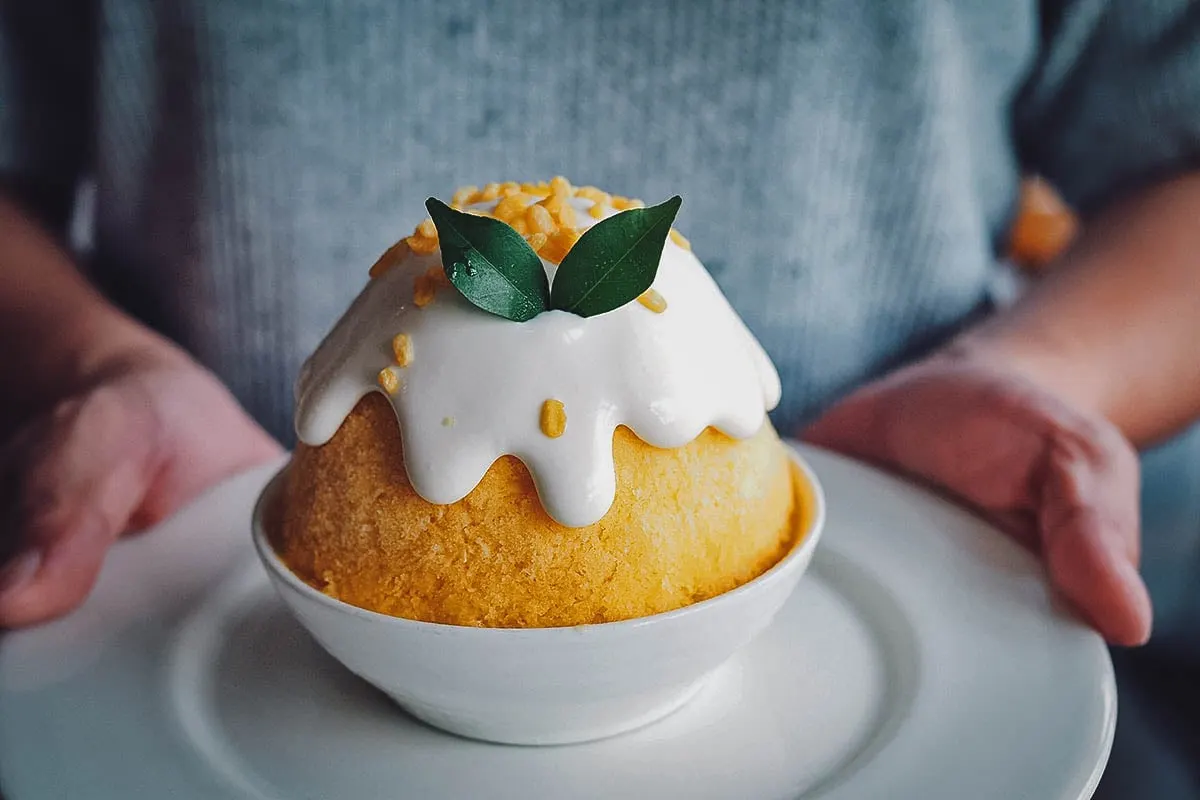
Photo by Theerawan
20. Soft Cream
Last but certainly not least is soft cream. A common sight in Japan, this ubiquitous dessert is what the Japanese call soft serve ice cream.
Do you remember what I said about Hokkaido dairy making everything better? That’s the case with soft cream. It’s delicious anywhere in Japan but especially in Sapporo or anywhere else where it’s made with Hokkaido milk.
Vanilla-flavored soft cream is the most common but my favorite is the matcha flavor. It’s earthy and delicious, especially when made with green tea powder from Uji.
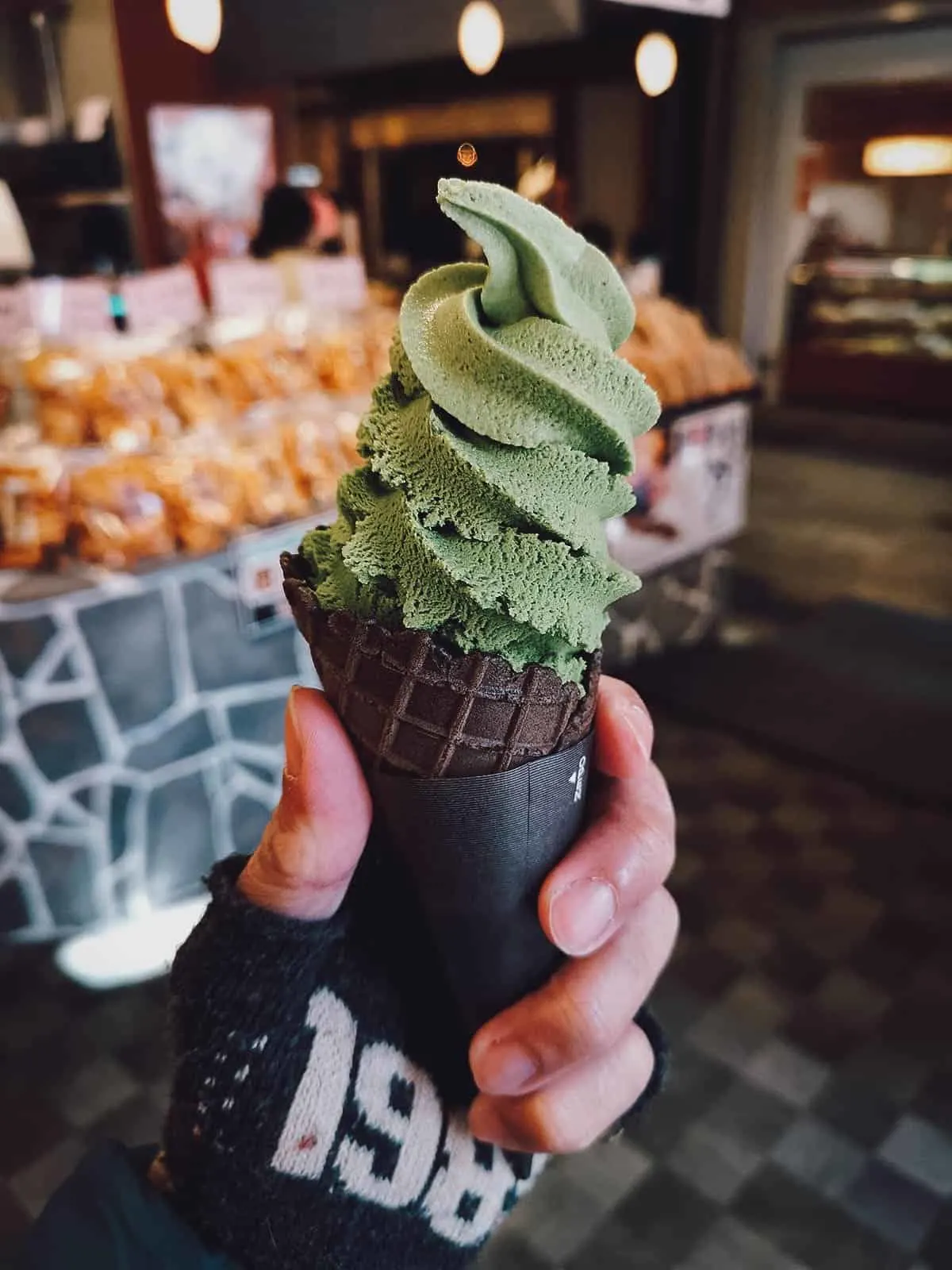
FINAL THOUGHTS ON JAPANESE DESSERTS
Like everything else in Japan, traditional Japanese desserts are delicious. Japanese people have the most exacting standards and that translates into everything they do, including their desserts.
If I were you, I’d try as many Japanese desserts as I could, but if I had to narrow them down to just three, then I’d say go for soft cream, mochi, and Japanese cheesecake. Those are three of my personal favorite Japanese desserts and something I’d look for on every return trip to Japan.
In any case, I hope you enjoyed reading this article on popular Japanese desserts as much as I had fun writing it. It’s already making me look forward to our next trip to Japan! Arigato gozaimasu!
Disclosure
This article on the most popular Japanese desserts contains affiliate links. If you make a purchase, then we’ll earn a small commission at no additional expense to you. As always, we only recommend products and services that we use ourselves and firmly believe in. We really appreciate your support as this helps us make more of these free travel and food guides. Thank you!
Cover photo by Chagiya_1.8.18. Stock images via Shutterstock.

